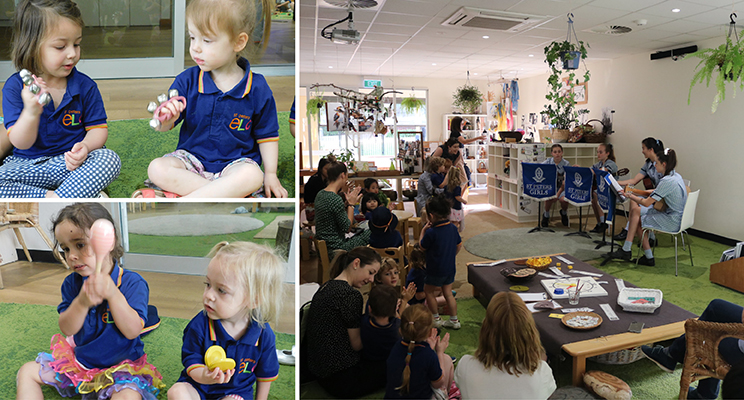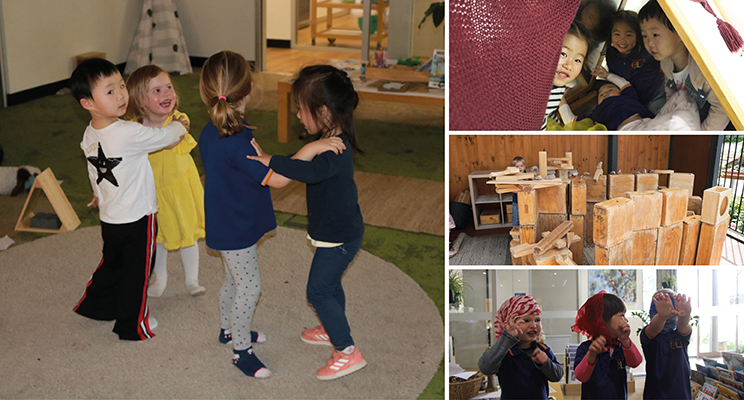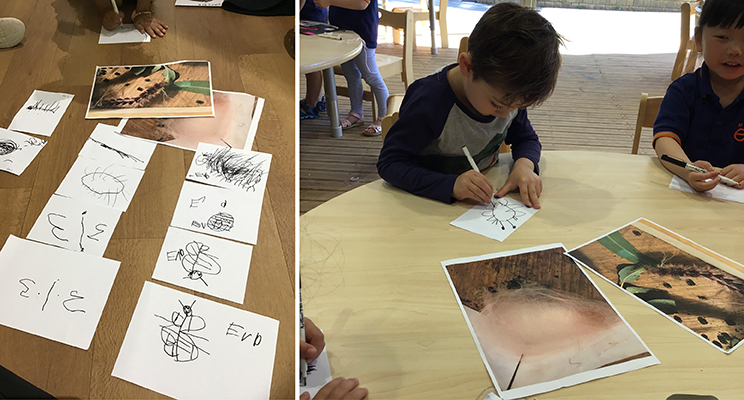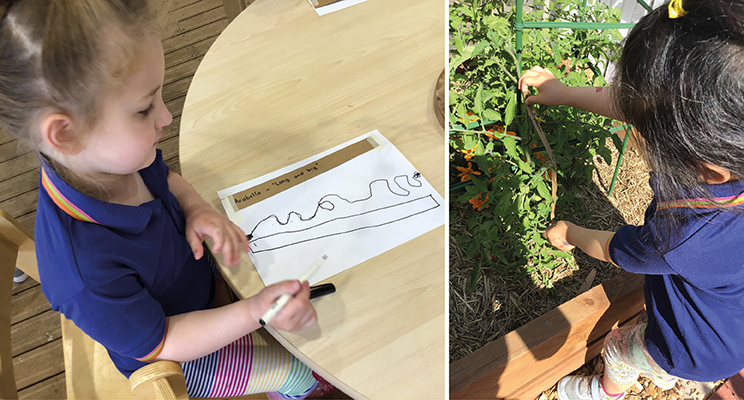From the Assistant Director of Early Learning
Dear Families
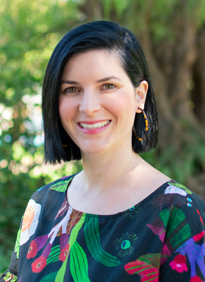
This year started with a strong emphasis on collaboration and associated values with our mission. In order to have respectful relationships, we needed to give value to inclusion across the Centre. As we began to unpack our values and beliefs as a staff team, we called upon our School colleagues for expertise and dialogue. One of these professionals was EAL/D Specialist Trish Tynan, who has attended our Tuesday morning briefings to give the topic of inclusion ongoing focus and direction.
Recently, Laura Reiters and I met with Co Mai, Inclusion Professional from Gowrie SA – Inclusion Agency, as we applied for an Inclusion Aware Certification. Laura and I shared with Co and his colleague our mission, values and approach to inclusion. At the end of last week, I was extremely proud to receive notification that St Peter’s Girls’ Early Learners’ Centre has been successful in applying for Inclusion Aware Certification.
This certification demonstrates that we have a consistent and considered approach about environments, resources and planning to support the welcoming of children (and families) with a diverse range of abilities, interests and backgrounds.
The educators are dedicated to the inclusion of all children and families at our ELC, and we are extremely proud to share this certification with our staff team, families and wider School community. This is a wonderful recognition for our team who work extremely hard on a daily basis.
I look forward to seeing you at our ELC Christmas Celebration which is being held on Chiverton Lawns this Friday 22 November, starting at 5pm. Please bring your Christmas cheer as the children are extremely excited to share with you some of their favourite ELC songs.
Kind regards
Kirsty Porplycia
Assistant Director of Early Learning
Save the Date
Friday 22 November: ELC Christmas Celebration, 5pm
Monday 2 December: ELC Hat Ceremony, 12.15pm
Thursday 5 December: ELC Farewell Afternoon Tea for Learning Community 2, 2.30pm
Friday 6 December: Last day of Term 4
Monday 9 December: Vacation Care begins
December 23 – January 3: ELC Closed
ELC Christmas Celebration
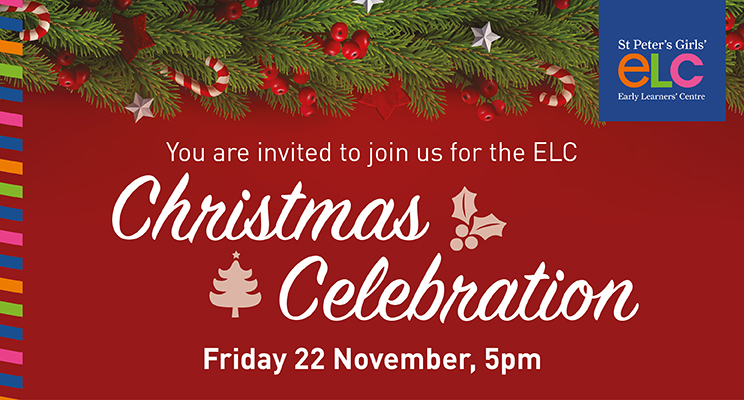
Join us on Chiverton Lawns for our ELC Christmas Celebration this Friday 22 November at 5pm.
We ask that children arrive at the ELC at 5pm, as they will begin presenting promptly at 5.15pm.
Families can bring their own picnic basket, rug and nibbles. Drinks will be available to purchase. Mercato and Chesini House are generously donating pizza slices.
We look forward to celebrating a wonderful year with our beautiful community.
Christmas Giving Tree
The ELC Christmas Giving Tree is our chance to brighten the lives of families less
fortunate this Christmas.
We are asking for donations of toys and books for children aged 6 to 12. When donating gifts, please ensure they are new, unwrapped, and smaller than a school backpack.
Some examples are:
• Educational toys and books
• Small sporting items
• Puzzles and board games
• Drink bottles and pencil cases
• School stationery packs
No second-hand or home-made items please.
All donations placed under the tree will be collected on Friday 6 December and delivered to The Smith Family Toy and Book Appeal.
Learning Community 2 Farewell Picnic
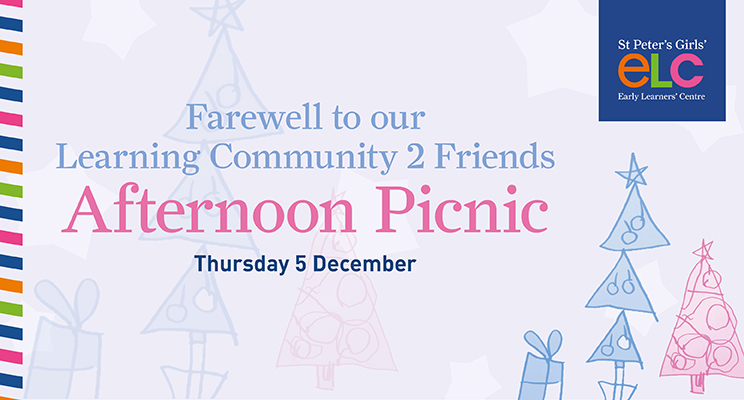
Families of Learning Community 2 children are invited to the ELC for a picnic to farewell our friends and celebrate a fun and successful 2019.
Thursday 5 December
2.30 – 3.30pm
ELC Hallett Garden
Afternoon tea will be provided.
Vacation Care Bookings
Vacation Care begins on Monday 9 December. Booking forms are available this week; if you haven’t received one, you can download a copy here.
Please note that the ELC will be closed from Monday 23 December and will reopen on Monday 6 January. Term 1 begins on Wednesday 29 January 2020.
Sun Safety in the ELC
Please can your child bring to ELC, each day that they attend, a broad brimmed hat. If you do not have an ELC uniform hat, we ask that you pack another broad brimmed hat for your child to wear at ELC. As we move into the warmer months, it is extremely important that we adhere to our policies and procedures. If your child does not have a hat, they will be asked to play under the shaded areas or indoors.
Please note that sun cream application is also being undertaken regularly at the ELC; if your child requires an alternative sun cream, please provide this to your child’s educator. We also ask that your child wears their correct ELC uniform, and refrains from wearing dresses or singlets where the shoulders are exposed. Appropriate footwear is also required and we ask that children wear sneakers or sandals that have a backing to them.
Children’s Lunch Boxes
With the weather warming up, it is important that your child’s lunches are prepared and stored safely to avoid the risk of food poisoning. Keep pre-made lunch boxes in the fridge until they are ready to be packed into your child’s bag. We ask that you pack a frozen ice block/ice pack in your child’s lunch box to keep food cold. Please consider healthy, safe lunch box alternatives such as fruits and vegetables, and please ensure your child has a drink bottle filled with water each day they attend ELC. The staff can refill the bottles if required throughout the day.
Absences in the ELC
Student Absences
Please notify the School via one of the following methods for late arrivals/early departures and absences, ensuring a reason for the absence is included.
Text: 0428 601 957 (save to phone contacts as SPGS)
Email: attendance@stpetersgirls.sa.edu.au
Phone: 8334 2200 or phone the relevant room as per the contact list
Feel free to also include the relevant room teacher when sending via email.
ELC Room Contacts:
Bell Yett – 8155 5777
Ferguson – 8155 5776
Hallett – 8155 5775
Stonyfell – 8155 5778
来自黄老师的信息
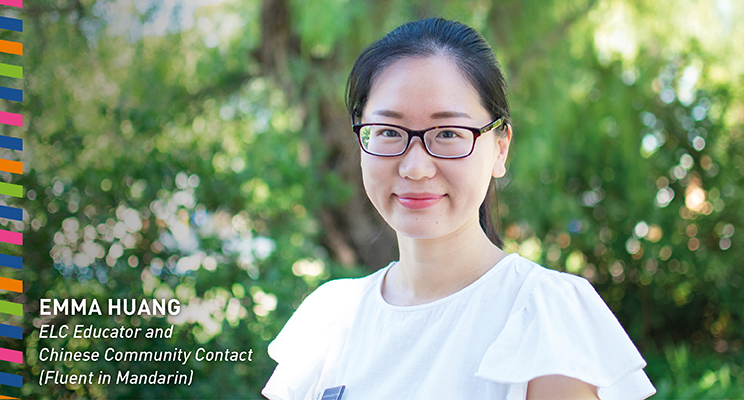
11月22日周五下午5点: ELC圣诞庆祝
12月5日周四下午2点半:ELC下午茶 欢送第二学习社区小朋友进入小学阶段学习
12月6日周五:第四学期最后一天
12月9日周一:假期托管服务开始
12月23日到1月3日:ELC休息
如果您需要假期托管服务,请确保填写假期托管服务表格并交还ELC。
Emma works in Learning Community 2 on Mondays, Thursdays and Fridays from 9am – 5pm.
Learning Community 1
News from the Stonyfell Room
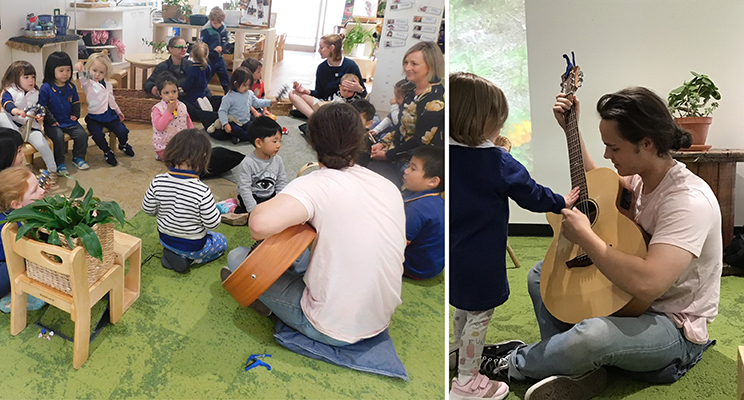
In the past two weeks, we have been creating memories that will be with us for many years. Through community, storytelling, music and Kaurna language, we have created a beautiful song that children and adults across the Centre have embraced: The Ritual of the Rock.
Working alongside different members of the community including Nanny Heather (Hudson Duldig’s grandmother), Ned Baulderstone (Ms Angel’s son and singer/songwriter) and Uncle Tamaru (Kaurna elder and friend) we have taken the gift of a special rock, created lyrics, and now, music together.
It is a rock,
It is a rock
It has a heart,
It shines in the rain
It has a heart,
The heart of our land
Nanny Heather, she gave us the rock,
Nanny Heather, she gave it to us
It was found, on Kaurna Yerta,
It was found, on Kaurna land.
Marni ai, it means feeling happy,
Marni ai, it means feeling good
It is a rock, it is a rock!
Every Friday morning, Learning Community 1 is gathering in the piazza to say our Kaurna Acknowledgement to Country and to sing this song. We invite you to join us for this any time you are free. This is a way in which you can participate in our learning, our culture and our joy. A way in which you too can become a part of our shared memories here in the ELC.
Mel Angel
News from the Bell Yett Room
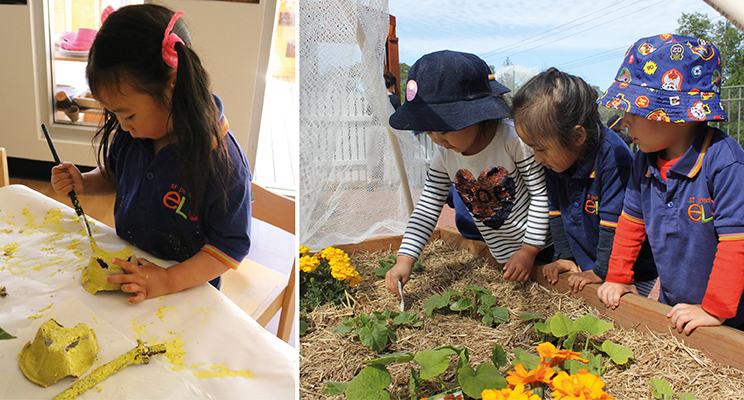
“The moment we decide to fulfil something, we can do anything.”
– Greta Thunberg
Not only as educators of young children, but simply as citizens of this world, we have a fundamental responsibility to educate our children to become socially responsible and respectful of the environment they are growing up in. At our ELC, we believe through commitment to sustainable practice, we are creating crucial lifelong skills and knowledge about how to care for our planet, and why it is so important to do so.
Creating environmental awareness is simple. By maintaining a dialogue from day one and by taking the time to explain the why behind our practices, our children are serious about taking action. They come to consider caring for the land as something that people have to do. Every day in Learning Community 1, we are:
- Mindful to only have the taps on for a short time to wash our hands, so as not to waste water
- Recycling correctly; ensuring paper goes into the paper waste bin and that recycled plastics are cleaned before they go into the recycling bin
- Ensuring to use both sides of the paper when we are drawing, and brainstorming a second use for the paper when we are finished with it
- Sorting our food scraps and determining which can go into our worm farms and which are to be composted
- Creatively finding a second use for recycled materials in art experiences
- Collaborating closely and a sharing knowledge and new ideas with the children and educators in Learning Community 2
When exposed to and practised each day, our children are capable of taking on big ideas such as sustainability. If sustainable practices are embedded daily from a young age, they become the norm, habit, ritual. We are working hard every day to make our little patch of the world greener, and growing many young enthusiastic environmentalists along the way.
Annabelle Redmond
Learning Community 2
News from the Ferguson Room
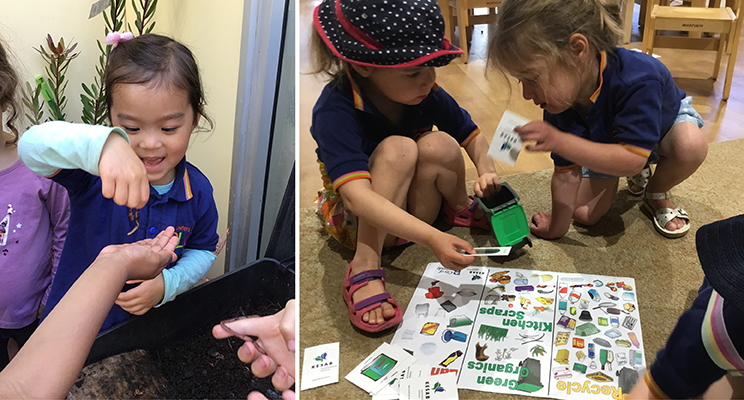
Sustainable Practices in Early Childhood – Creating Opportunities for Meaningful and Authentic Engagement
It is essential that children are considered to be capable to implement change and develop actions to support positive sustainable practices. It is imperative that all children have access to information and can participate in meaningful ways to address real-life issues.
If we look towards the current political landscape, our country is faced with a huge challenge right now. The recent and devastating fires across this country are raising important issues about environmental management and climate change. It’s pivotal that our children understand the impact that we have on the environment and the responsibility we need to take, and what we can do to initiate change.
Responsibility is not passive; it requires engagement and the potential for action. Supporting children to become environmentally responsible requires meaningful opportunities for children to engage in authentic experiences and to be active participants and decision-makers.
What does this look like in Learning Community 2?
The children have been implementing change over the past few months and they have become passionate and invested contributors. We have begun with taking realistic actions that are achievable. This has included an audit of our bins and our waste. We have been exploring where waste goes, how we can limit the amount of waste we create and how we can correctly dispose of it. The children have worked together to colour-code the bins and learn what goes in each bin. We regularly take the appropriate green waste to our worm farm and we are collecting the ‘worm tea’ to use on our community garden. The children have also been involved in exploring and unpacking a range of stories with an ethical focus. The children have been questioning the content and thinking of ways they can solve these issues.
This festive season, we have continued to provoke the children’s thinking and we are encouraging them to create and decorate our spaces by only using materials that have been recycled. To support this, we are asking that you bring in recyclable materials we could use such as:
- Bottle or jar lids
- Clean and washed containers
- Boxes
- Old ribbon or cards
Laura Reiters
News from the Hallett Room
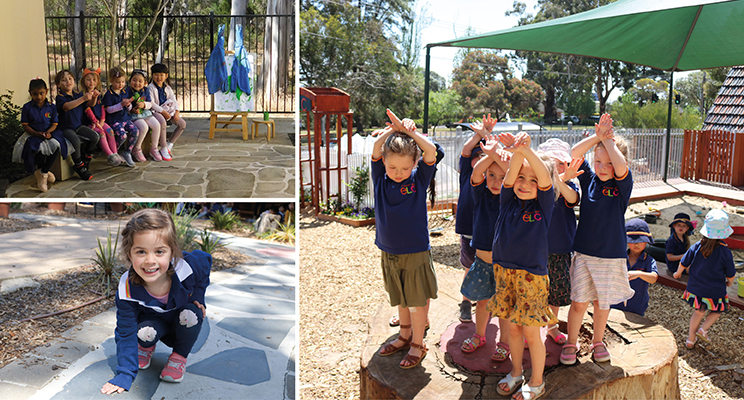
“Space has to be a sort of aquarium that mirrors the ideas, values, attitudes, and culture of the people who live within it.” – Loris Malaguzzi
As the children deepen their connections to our places, we have been unpacking our Central Idea, ‘Shared memories can enrich a community’s history.’ Inviting the children to share Ms Caterina’s ‘history bag’ or playing a game of matching on the path has enabled us to reflect upon and celebrate our memories of past inquiries.
There are special places at the ELC that our children will remember forever and are part of their everyday life. The History Bag was created with memories of special places at the ELC. The bag contains objects able to evoke memories of meaningful places in our community:
- The Path
- The ELC Community Garden
- The Friendship Garden
- The Twisty Tree
“The Twisty Tree is now a climbing log; we can play on it.” – Angelique
“We played on the Friendship Tree in Ferguson Park, it’s a symbol on the path.” – Erica
“Sometimes we have morning tea in the Friendship Garden.” – Arabella
“I remember the caterpillars; they were dancing”. – Emily D
Together, we have explored our history, in particular, the special places in the ELC the children have connected to. We want to conclude the year, sharing experiences and valuing our past, to create a community narrative where creativity and knowledge meet.
We asked the children, ‘What is history?’
“Stories from the past.” – Harper
“Stories from a long time ago.” – Sofia C
To know our history can enhance the values of a community and enrich the connection with places and culture.
Nell Tierney and Leanne Williams

